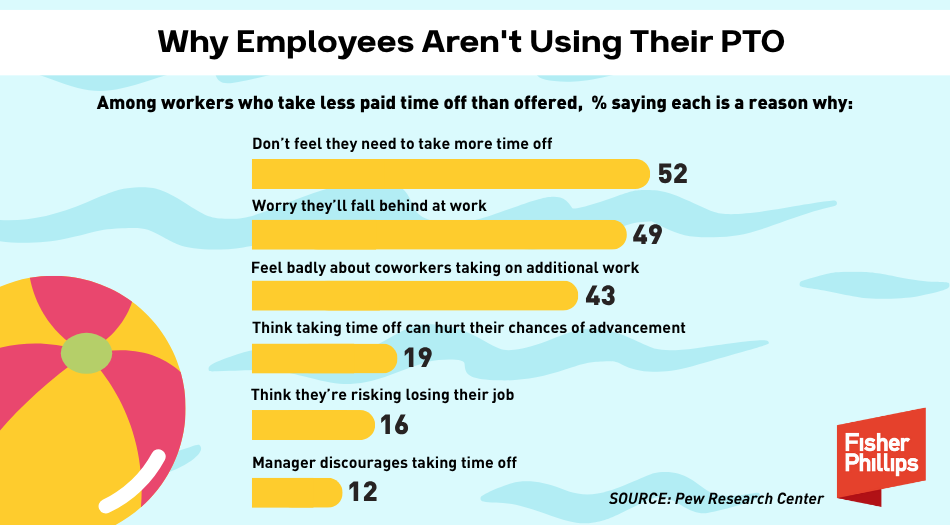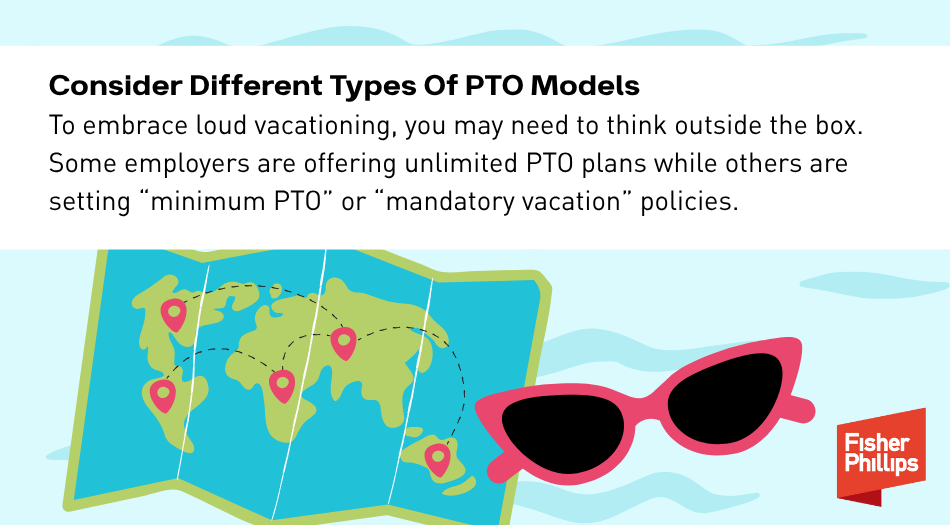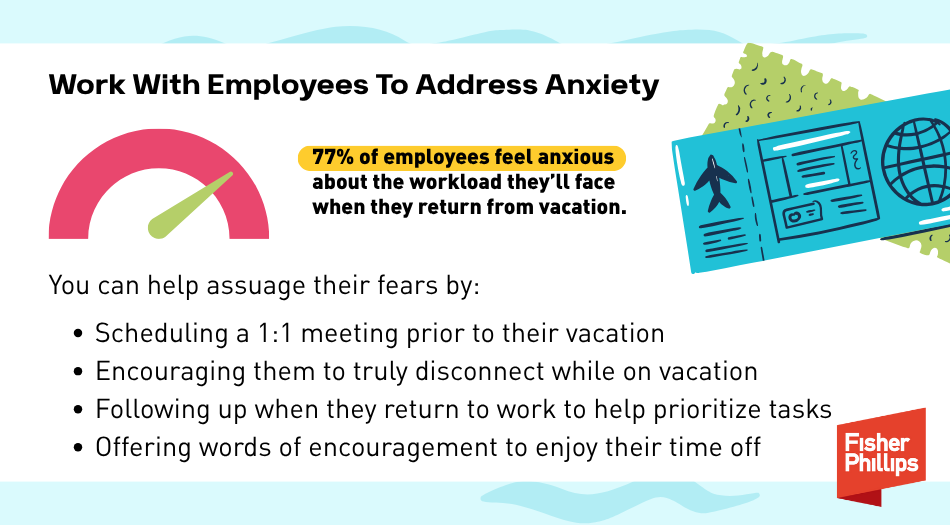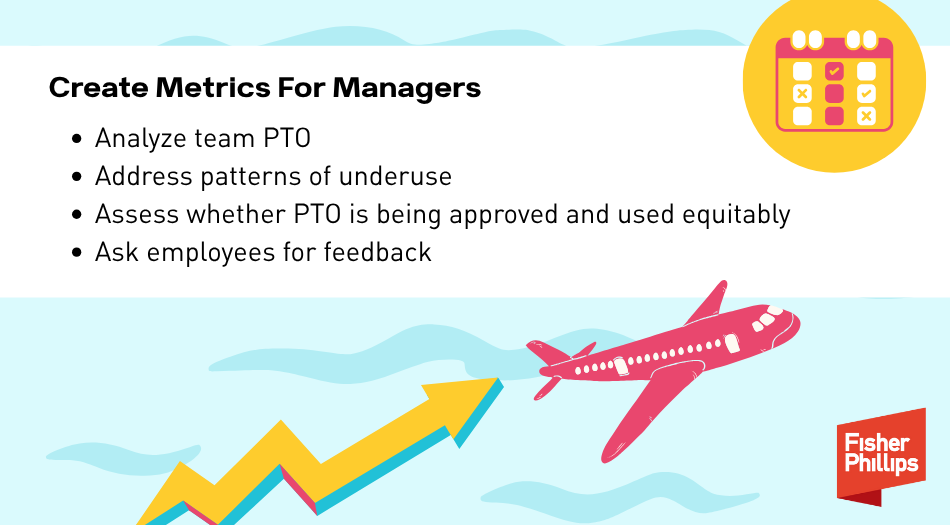Your Employees Are Embracing “Loud Vacationing” And So Can You: 7 Tips For Building Supportive PTO Policies
Insights
6.06.25
The trend for workers to hide their time off from their managers – known as “quiet vacationing” – has taken a sharp turn. Employees are now “loud vacationing” by openly sharing their travel plans and using their paid time off (PTO) without hesitation. While this should be a welcome shift for employers, it also highlights the importance of creating supportive policies that balance employee well-being with workplace productivity. How can you help your employees and your business thrive this summer and beyond? Here are seven tips to help you refresh your PTO policies.
1. Start By Reviewing The Latest Employee Trends
Here’s why you should consider revisiting your organization’s approach to PTO and start encouraging loud vacationing:
- 85% of employees believe that vacations boost their happiness (Empower).
- 46% don’t use all their allotted PTO in a year (Pew Research Center).
- 47% feel guilty about taking a vacation (Glassdoor).
- 68% say they work during vacation (Glassdoor).
2. Create A Plan To Revamp Your PTO Program
There’s no one-size-fits-all PTO plan, and your policies will depend on the unique needs of your business. However, as you consider updating and modernizing your program, you can start by asking yourself the following questions:
- How do your PTO policies stack up against offerings from your competitors and other businesses in your area?
- Are you providing enough time off each year for employees to disconnect as needed?
- Do you have an adequate system for tracking and approving PTO use?
- Do you have clear procedures for handling requests at popular times or during your busy season?
- Have you asked employees for feedback about their experience requesting or using PTO?
- Have you identified any patterns of underuse organization-wide or in particular departments?
- Do you have a legally compliant cap on accrual of paid time off or a legally compliant PTO policy?
- Do your policies comply with all applicable federal, state, and local leave laws?
3. Consider Different Types of PTO Models
To embrace loud vacationing, you may need to think outside the box. But first, let’s talk about unlimited PTO models, which have become popular in recent years. Under these plans, employees don’t have a set number of PTO days, accruals, or caps. Instead, they request paid time off as needed or desired and managers use their discretion to approve or deny such requests. These policies place no cap on the amount of time an employee can take off.
The benefits of an unlimited PTO policy include:
- More flexibility for employees to take the time they need, when they need it, rather than waiting for PTO to accrue.
- May be a good recruiting and retention tool, as it promotes autonomy over the employees’ own work-life balance.
- May avoid employee burnout.
- Reduced administrative costs for employers in tracking PTO.
- Cost savings, as in some states there is no need to pay out unused PTO days at the end of the employment relationship if the employer truly has an unlimited PTO policy.
But watch out for these potential pitfalls of unlimited PTO policies:
- You may have employees who prefer to “earn” accruals rather than use their discretion in taking time off.
- Some employees may request less time than they need while others may request excessive time off.
- Managers may not apply and enforce policies consistently, which could lower morale or lead to discrimination claims.
- Although the purpose of a vacation allowance is to encourage employees to disconnect and recharge, they may be frustrated if they can’t cash out unused vacation time upon separation – especially if your old policy allowed it or state law requires you to pay out accrued vacation at termination.
- Combining vacation and sick time off may run afoul of various state and local sick leave laws.
- Some states may still classify unlimited PTO as “earned wages” depending on how the policy is structured and applied – so check with your attorney on the legal nuances for your locations. For example, you can read about California-specific issues here.
To address some of the concerns with unlimited vacation programs, some employers are setting “minimum PTO” or “mandatory vacation” policies – meaning they require employees to take at least a certain amount of time off a year.
The benefits of this type of policy include:
- Helping prevent burnout and encouraging better work-life balance by ensuring employees take breaks from work.
- Helping managers plan for absences and schedule work assignments accordingly.
- May be a good recruiting and retention tool.
- You can be flexible in your approach. For example, an unlimited policy can be combined with a minimum requirement to reap the benefits of an unlimited PTO plan and address some of the pitfalls (like the fear of taking time off that’s not “earned”). You can also combine minimum PTO with accruals or other policies that provide a set number of earned vacation time per year to avoid high cash outs or rollovers at the end of the year if offered by your company or required in your jurisdiction. However, be vigilant of state specific requirements, such as California-specific issues relating to accrual caps and payment of PTO at separation.
- You can still award employees with extra time off based on tenure, for example, by raising the minimum for employees with seniority.
A word of caution:
- You’ll want to ensure your written policy is developed and implemented carefully so that the minimum doesn’t unintentionally become the maximum. We’ll discuss corporate culture in more detail below.
4. Work With Employees To Reduce Anxiety
According to Glassdoor’s research, 77% of employees feel anxious about the workload they’ll face when they return from vacation. You can help assuage their fears by:
- Scheduling a 1:1 meeting prior to their vacation to go over any projects or tasks that will need to be reassigned to other employees during their absence.
- Encouraging them to truly disconnect while on vacation and reassuring them that you have an adequate work-coverage plan in place.
- Following up when they return to work to help prioritize tasks and manage their workload.
- Offering words of encouragement to enjoy their time off and welcoming them back when they return.
5. Create Metrics For Managers
You’ll certainly want to train your managers on your PTO philosophy and policies. But you can go a step further in the spirit of loud vacationing by developing performance metrics for managers based on time-off objectives for their teams. Consider doing the following:
- Analyze team PTO use to ensure sufficient time is being taken by all employees.
- Address patterns of underuse. Is the manager discouraging vacation use or are employees hesitant to take time off for some reason? Get to the root of the issue.
- Assess whether PTO is being approved and used equitably across the team. If not, find out why and address any disparities.
- Ask employees for feedback. You can periodically survey employees to find out what is and isn’t working for them. Just remember that if you ask employees for their input, it’s important to follow up and address their concerns.
6. Don’t Forget The Legal Stuff
- Ensure your PTO policies align with all applicable federal, state, and local leave laws – including paid family leave, paid sick leave, and accrual requirements. Note that some states have banned “use-it-or-lose-it” PTO policies or require employers to pay out accrued but unused PTO at the end of employment.
- Employers with multiple locations may need to make jurisdiction-specific adjustments.
- Be sure to create a clear and objective process for approving or denying vacation requests, whether based on performance issues, busy seasons, or seniority during popular vacation times.
- Document your legitimate business reasons for denying requests. Make sure decisions are made consistently and fairly to reduce the risk of discrimination claims. Consult with legal counsel, if needed, to ensure the denial doesn’t interfere with protected leave.
- Train managers on PTO policies and basic leave-law compliance and let them know who to contact on your HR or legal team when issues arise.
7. Lead By Example
We’ll end with one of the most important aspects of a thriving workplace culture: Remember that your senior leadership team sets the tone for the entire organization. To embrace loud vacationing, your leaders must prioritize and value their own time away from work – and they should let your employees know about it.
To set the tone, think about taking these actions:
- Encourage senior leaders and all managers to mention in their internal out of office message that they are on vacation and disconnecting while away. Be sure they designate a point person for critical issues in their absence.
- Talk about PTO in team meetings. Give space for employees to share their vacation plans or post-vacation stories – but also be sure to respect their privacy.
- Create a space on your internal portal or team site where employees can voluntarily share their vacation photos. (You can designate someone in HR to upload submissions and ensure professionalism.)
Conclusion
We will continue to monitor developments in this area and provide updates as warranted, so make sure you are subscribed to Fisher Phillips’ Insight System to get the most up-to-date information. For further information, contact the authors of this Insight or your Fisher Phillips attorney.
Related People
-
- Anet Drapalski
- Partner
-
- Ilanit Fischler
- Partner
-
- Lisa Nagele-Piazza
- Lead Content Counsel










